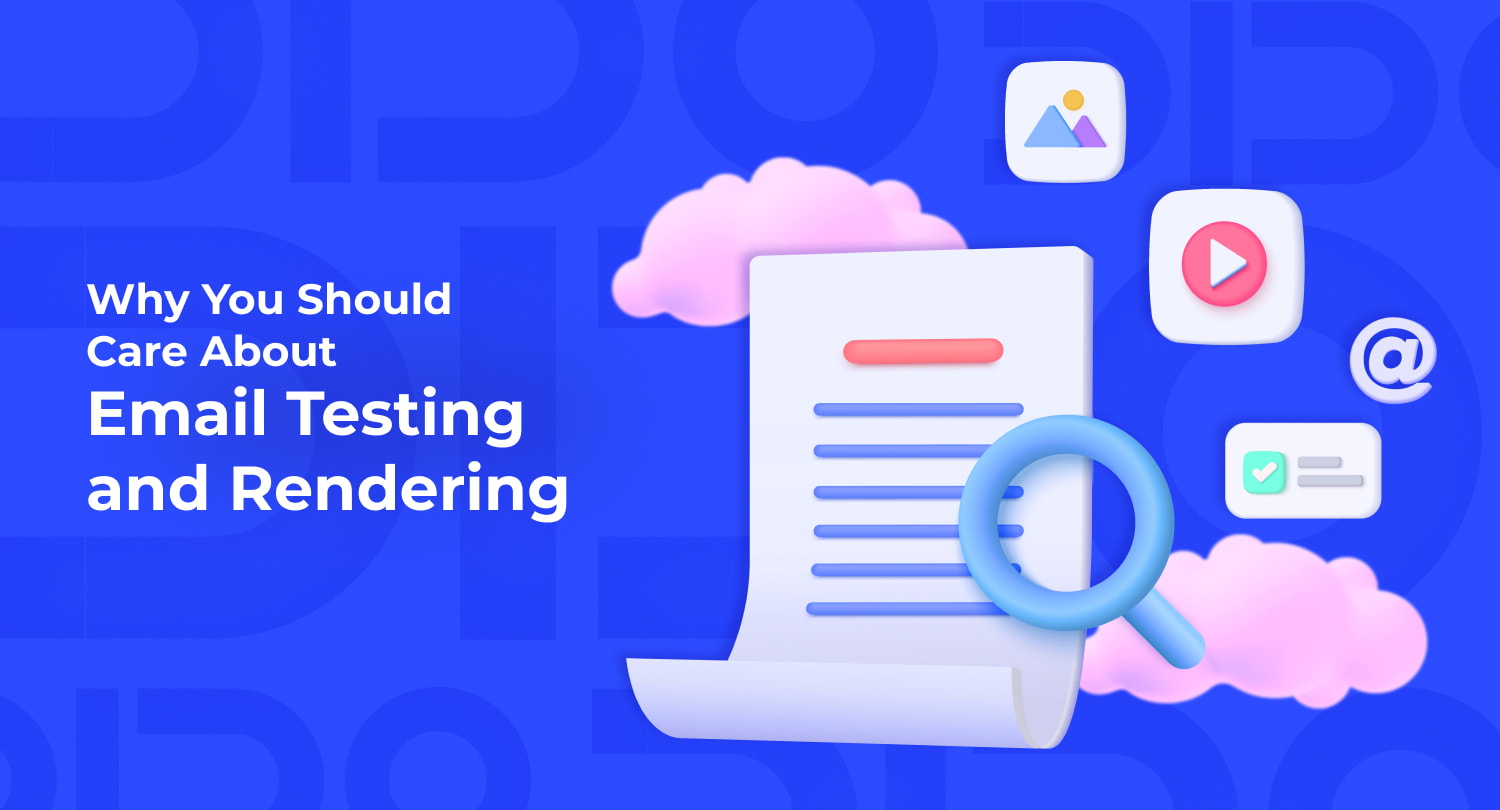Think about your perfect email. Eye-catching design, snappy and witty copy, and an incredible CTA… a true sales magnet. You send it from your laptop, open it on your iPhone, and… oh no. The formatting has changed, the GIFs aren’t working, and your boss is ringing your phone off the hook. What went wrong? Our guess? Email testing and rendering weren’t fully leveraged in the preparation of your campaign!
Considering your user’s experience needs to start long before you click “send” on your finished campaign. Sure, you need to include personalization, dynamic design, and good copy, but that means nothing if your subscribers on Outlook, Gmail, or other ESPs don’t have the same experience.
As an email marketer, it’s your responsibility to make sure that every email campaign (yes, every single campaign) is tested for any issues before any consumer sees the email. Your team should develop a testing and rendering plan to quality-check your emails and work on increasing your ROI.
If you’re not sure how or why to start testing and rendering processes, this blog will take us back to basics together. We’ll guide you through what email testing and rendering are, why you should care about them, and important strategy checkpoints to keep top of mind. Ready?
What is Email Testing?
First, let’s answer the question: what is email testing? Well, it’s exactly what it sounds like! Email testing is testing your individual emails and/or campaigns prior to sending them out to your subscriber list. Testing includes double-checking links, ensuring designs show up correctly, addressing any spelling and grammatical errors, and anything else that might pop up along the way. Many platforms — like Klaviyo — offer their users a way to preview the email as a web page or even send a test email to themselves, so make sure to consistently use these features.
Testing your emails can help you correct things like:
■ Incorrect email design.
■ Broken or mistakenly placed links.
■ Wrong “From” name.
■ Poor subject lines and/or preview test.
■ Broken or poor-quality images.
■ Missing alt text for accessibility.
■ Irregular font, colors, or display.
The goal of testing your emails is to notice and correct errors and issues before your consumers receive your email; the last thing you want is for your recipients to be the ones pointing out the errors to you!
Why is Email Testing Important?
Now that you know what email testing is… who cares? Why should we test our emails?
Email errors may seem small, but they can have a huge impact. Errors, typos, and other mistakes can not only cost you customers and revenue but can also diminish your credibility. Think about if you included a link to the wrong landing page or an improperly formatted discount link. Not only does it not look like you know what you’re doing, but it also gives the impression that you don’t care! Customers will start to lose trust in your brand and, as a result, your open rates, click-through rates, and ROI are all likely to decline.
Let’s think about it with a small-scale example. You’re preparing a campaign promoting your new product, but you don’t think to test it for mobile … it’s worked before, so no need, right? You’re sending this email to 1000 subscribers, and you anticipate $500 in sales. However, 50% of your subscribers open your email on their cellphones, and they can’t read the copy or click on your links, so they delete it. That cuts your audience from 1000 down to 500, and your potential earnings from $500 down to $250 (and that’s only if every remaining customer converts!). We bet that you’re probably wishing you tested that email right about now.
With valuable ROI on the line, email testing becomes a necessity, not an option. Every single email and campaign needs to be tested to find errors and fix them before your audience gets the email. Errors = lost sales!
What is Email Rendering?
At this point, we can all safely agree that email testing is crucial, but email rendering is just as important. But first, what is email rendering?
Email rendering refers to how an email is displayed on different browsers, ESPs, email clients, and devices. How your email renders is another thing that you need to test and check!
Why is Email Rendering Important?
Email rendering is important primarily to ensure a good user experience, and secondarily to ensure that your emails accomplish what they’re set out to do. If a client can’t see your email properly, you probably won’t get the conversions or open rates that you want.
There are five major considerations that impact how an email displays and all 4 are equally important to think about during email creation, design, and testing.
1. Operating System
While Microsoft Windows and Apple macOS may be the most popular OSs, there are other options to consider. Don’t forget about Linux and GUI, as well as mobile OSs like Apple iOs and Android.
2. ESPs
There are tons of ESPs out there — from MailChimp to Salesforce to Klaviyo (our favorite) — with completely unique display features. Keep the differences between them in mind when you’re crafting emails.
3. Screen Size
From the smallest handheld smartphone to the largest tablet or desktop, there are hundreds of screen sizes in-use every single day. Remember while designing your emails that they need to be able to render properly on as many of these screens as possible.
4. Email Clients
Much like the range of ESPs, the range of email clients out there is vast, too. Gmail, Outlook, Yahoo, Apple Mail, Windows Live, GMX… each of these clients display HTML differently, have different features disabled/enabled, or have images disabled/enabled. You’ll want as many email clients as possible to properly render your email, so keep this in mind.
Being consistent with your email testing and rendering is important for continued success. Operating systems are continually changing, and ESPs make changes that can affect your coding, and trends ebb and flow… basically, everything about the world of emails is constantly changing, and you need to stay updated.
Maintaining and adapting your rendering and testing strategies have a direct impact on your email success, ROI, and revenue. It’s key that, as an email marketer, your emails are keeping up with current standards and capabilities.
How to Test and Render Emails to Improve your ROI
So, you know what testing and rendering are, and why they’re important. But how do you add them to your existing strategy? In the next section, we outline our process for testing, as well as best practices to ensure proper rendering.
Testing Your Emails
The best way to test your emails is to send out drafts to real devices. What does that mean?
1. Send a Test Email Through:
a. An ESP
Most ESPs — including our ESP of choice, Klaviyo — include email testing in their platform capabilities. When your email or campaign is created in Klaviyo, you can send a test email to an address (or multiple addresses) of your choice. We’d recommend sending a test email to multiple departments (design, copywriting, etc.) so they can all preview what it looks like, and check for job-specific errors.
b. A Third-Party Site
2. Send a Test Email to a Real Device
If your ESP doesn’t have a test send option, you can also use a third-party testing service to accomplish the same thing. PutsMail, for example, allows you to bypass your ESP and test your email by inputting your HTML and workshopping your design.
This one may seem like a no-brainer, but the best way to test an email is to send it to a real device! It’s probably a safe guess that everyone on your team uses slightly different devices, whether it’s different OSs or different versions of a similar device. By sending emails to real devices that real people use, you can see exactly how they’ll look and perform when you actually send the email.
Once you figure out your preferred testing strategies — either through your ESP or a third-party service — and decide who will receive your test emails, this needs to be done every time you send out an email campaign. This process needs to become a habit of your email marketing process to make sure your users have a great experience with every email.

Rendering Your Emails
Unlike the very straightforward testing process, the rendering process is not as clear-cut; each individual email client has their own policies, priorities, and rules. Despite these differences, though, there are still best practices that you should follow to make sure your emails are displaying correctly.
■ Background Images: Ensure that images used in your design have a fallback background in case a recipient’s OS/client/etc. disables the image. Seeing a solid, on-brand color is preferable to a giant blank space!
■ Email Size: The “Golden Rule of Email Sizing” is to keep your emails around 600px. You’ll also want to make sure that your email is less than 102kb to optimize access to email clients (especially since clients like Gmail clips emails over this size).
■ Fonts: Similar to image fallback, you should always set fallback fonts in case your chosen fonts are disabled by email clients. Outlook is a huge culprit for disabling fonts, so fallback fonts are key to making sure you don’t give users a poor experience no matter which email client they use.
■ Buttons: If you’re including buttons in your email design, keep in mind that email clients will display these buttons differently. Building a bulletproof button that includes CSS and HTML instead of an image increases your chances of proper button rendering for all email recipients.
The best way to figure out how to integrate testing and rendering into your email marketing strategy is to test the processes themselves! Figure out which methods work best for you, your team, and your ESP, and how you can start including best practices in your creative process. Once you decide how these concepts fit into your strategy, it’s time to implement them. Your subscribers will never have to deal with error-laden, poorly rendered emails again!
Wrap Up
As email marketers, it’s your job to make sure that only the highest-quality email content is arriving in your subscribers inboxes. Your emails are a direct reflection of your company, so to maintain your credibility — and continue increasing that ROI and revenue— you want error-free, perfectly rendering emails. Better testing and rendering strategies mean new connections and conversions: ready to turn one-time buyers into long-term, loyal customers?
